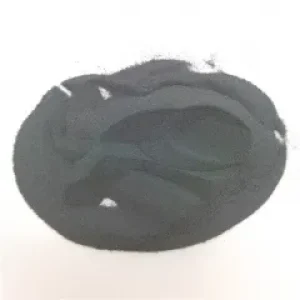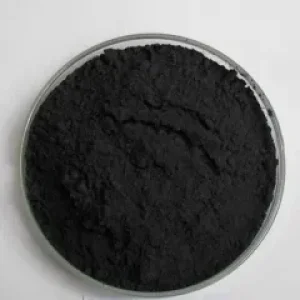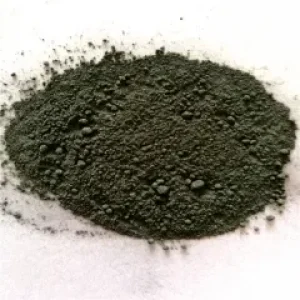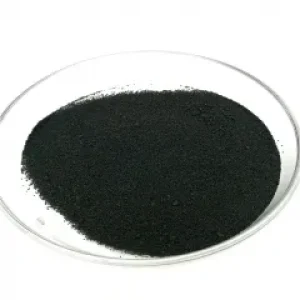Overview of Manganese Carbide Mn3C Powder
Manganese carbide is a stable compound formed by manganese and carbon. Manganese carbide formula is Mn3C, Manganese carbide melting point is about 1520°C, and Manganese carbide density is 6.89g/cm3. Manganese carbide burns rapidly in oxygen and decomposes in water to produce manganese hydroxide, methane, and hydrogen. It is easy to react with acid and be decomposed, easily react with chlorine and fluorine, and decompose into manganese and carbon at high temperatures.
The heat of the formation of manganese carbide is △fHm (298K)=-(15.06±12.55)kJ/mol. When smelting high-carbon ferromanganese or manganese-silicon alloy in a blast furnace or electric furnace, what is obtained is not pure manganese or manganese silicide but manganese carbide. Therefore, the heat absorbed by the reaction is less than that of reduction to metallic manganese or silicide. The reaction starts with the temperature is low. Therefore, high-carbon ferromanganese contains more carbon.
Performance of Manganese Carbide Mn3C Powder
Physicochemical properties of Mn3C: soft crystalline solid or bright needle crystal with a relative density 6.89. It is insoluble in concentrated sulfuric acid and nitric acid but can be decomposed by water or dilute acid to produce manganese hydroxide, hydrogen, and hydrocarbons. It burns rapidly in oxygen and reacts easily with fluorine and chlorine.
Production Method of Manganese Carbide Mn3C Powder
Carbothermal reduction method
The carbothermal reduction method is common for preparing manganese carbide, which is the reaction of coke or graphite with manganese oxide in an oxygen-free or weak oxidation atmosphere under high-temperature conditions. The reaction equation of this method is:
MnO2(s) + C(s) → Mn3C(s) + CO(g)
The reaction must occur at high temperatures, usually above 900 ° C. At the same time, the atmosphere in the reaction will affect the generation of manganese carbide; if there is a lot of oxygen, it will generate manganese dioxide. Therefore, to prepare high-purity manganese carbide, it is necessary to strictly control the reaction conditions. In addition, the coke or graphite used in the reaction needs to be rigorously treated to ensure that its impurity content is low, thus improving the purity of the manganese carbide.
Electrolytic method
Electrolysis is the process of using electricity to trigger chemical reactions. In the electrolysis process, manganese chloride and graphite are usually used as raw materials to generate manganese carbide by electrification in the electrolytic cell. The reaction equation of this method is:
MnCl2(aq) + 2C(s) → Mn3C(s) + 2Cl(aq)
Electrolysis can be performed at lower temperatures, usually around 800 ° C. At the same time, because the chemical reaction is generated by electrical energy, the reaction conditions and the structure of manganese carbide can be easily controlled. Additionally, the particle size and the morphology of manganese carbonite can be controlled with electrolysis by altering the frequency of the current and duration of electrolysis. However, the electrolysis method requires a lot of electricity, so the cost is higher.
Vapor deposition method
Vapor deposition is a method to deposit manganese carbide on the surface of the substrate by chemical reaction or physical deposition. This method uses raw materials from methane, hydrogen, nitrogen, and other gases. It reacts with manganese oxide under high temperature and pressure to generate manganese carbide and deposit it on the surface of the matrix. The reaction equation of this method is:
MnO2(s) + 4CH4(g) → Mn3C(s) + 2H2O(g) + 2H2(g)
The advantage of vapor deposition is that the manganese carbide coating can be directly formed on the substrate surface, so high purity and high-density manganese carbide coating can be obtained. At the same time, because the temperature and pressure of the vapor deposition method are adjustable, the coating’s reaction conditions and thickness can be easily controlled. However, the equipment investment is large due to the need to use large reactors, precision control systems, and other equipment.
Mechanical alloying
Mechanical alloying is mixing metal or metal oxide powder by high-energy ball milling and ball milling to nanometer particle size. In the mechanical alloying method, metal oxide powder (such as manganese oxide) is mixed with metal (such as iron) powder and ball milling is carried out. And REDOX reaction occurs during the ball milling process, and manganese carbide is formed. The method has the advantages of simple equipment, convenient operation, and low production cost. However, the disadvantage of the mechanical alloying method is that it is difficult to prepare high-purity manganese carbide, and the prepared manganese carbide particle size is coarser.
Applications of Manganese Carbide Mn3C Powder
Wear-resistant material
Manganese carbide has high hardness and wear resistance and can be widely used as a wear-resistant material in various mechanical parts and tools. For example, the use of manganese carbide on the bucket of an excavator can improve its wear resistance and service life. In addition, manganese carbide can also be used to manufacture precision tools such as cutting tools, drills, and measuring tools to improve their hardness and wear resistance. Due to the high wear resistance of manganese carbide, it is widely used in mining and construction machinery as a key part of the wear-resistant material, such as excavator teeth, crusher hammer, and so on.
Cemented carbide
Manganese carbide is an important part of cemented carbide that can be mixed with cobalt, chromium, and other metals to make a variety of cemented carbides with high hardness, high strength, high wear resistance, and other advantages. Manganese carbide carbide is widely used in the manufacturing industry to process high-temperature alloys, stainless steel, and other difficult materials to improve its processing efficiency and product quality.
Magnetic material
Manganese carbide is highly magnetic and can be widely used as a magnetic material in various fields. Manganese carbide can be used in the power industry to manufacture high-efficiency permanent magnet generators and motors. In the information industry, manganese carbide can be used to manufacture high-density magnetic recording devices. In addition, manganese carbide can also be used to manufacture high-temperature superconducting materials and magnetic sensors.
Structural material
Manganese carbide has excellent strength and high-temperature properties and can be widely used as a structural material in various fields. In areas such as construction and Bridges, manganese carbide can enhance its strength, wear resistance, and corrosion resistance. In addition, manganese carbide can also be used to manufacture components in high-temperature equipment to improve their strength and durability at high temperatures.
Catalyst
Manganese carbide can be used as a catalyst in chemical reactions, such as alkane cracking and isomerization reactions. Manganese carbide catalyst has high activity and selectivity, which can realize green production of organic matter and effective utilization of resources.
Other applications
Manganese carbide can also be used in other fields. For example, manganese carbide can be used as a structural material in construction and automotive manufacturing and as electrode material in batteries and electrochemical devices. In addition, manganese carbide can also be used as a biological material in fields such as medical devices and artificial joints.
Storage Condition of Manganese Carbide Mn3C Powder
Manganese Carbide Mn3C Powder should be stored in dry, cool and sealing of the environment, can not be exposure to air, in addition should avoid the heavy pressure, according to ordinary goods transportation.
Company Profile
My Carbides is a trusted global chemical material supplier & manufacturer with over 12-year-experience in providing super high-quality carbides and relatives products.
The company has a professional technical department and Quality Supervision Department, a well-equipped laboratory, and equipped with advanced testing equipment and after-sales customer service center.
If you are looking for high-quality Carbides, please feel free to contact us or click on the needed products to send an inquiry.
Payment Methods of Manganese Carbide Mn3C Powder
L/C, T/T, Western Union, Paypal, Credit Card etc.
Shipment of Manganese Carbide Mn3C Powder
It could be shipped by sea, by air, or by reveal ASAP as soon as repayment receipt.
Package of Manganese Carbide Mn3C Powder
Vacuum packing, 100g, 500g or 1kg/bag, 25kg/barrel, or as your request.
FAQ
Q1: How toxic is manganese carbide?
Answer: Manganese carbide itself is not directly toxic, but inhaling its dust for a long time may cause irritation or damage to the lungs. Therefore, when handling manganese carbide, appropriate protective equipment should be worn and the workplace should be well ventilated.
Q2: What impact does the purity of manganese carbide have on performance?
Answer: The purity of manganese carbide has an important impact on its performance. High-purity manganese carbide generally has better stability and higher activity, and can better meet the needs of specific applications.
Q3: What factors affect the price of manganese carbide?
Answer: The price of manganese carbide is affected by many factors, including the cost of raw materials, the complexity of the production process, the relationship between market demand and supply, and the international economic situation. When market demand increases or supply decreases, the price of manganese carbide may increase; conversely, the price may decrease.
Q4: What are the physical properties of manganese carbide?
Answer: Manganese carbide is a black crystal or powder with a metallic luster. Its crystal structure is hexagonal crystal system, with a high melting point and a relative density of about 6.89g/cm³.
Q5: What are the chemical properties of manganese carbide?
Answer: Manganese carbide has a high melting point and thermal stability, and can resist high temperatures and oxidation. Under certain conditions, it can react chemically with other substances, but it is relatively stable at room temperature.








